Building regulations - proposed changes to energy standards, etc: consultation analysis
An analysis of the responses to the 2021 public consultation on a review of building standards relating to energy standards and associated topics, including ventilation, overheating and electric vehicle charging infrastructure.
4 Part 3 – Energy, all buildings
This section of the consultation introduces proposed changes to provisions which apply to new buildings and to new work to existing buildings. These are the provisions sought when demonstrating compliance with Standards 6.2 to 6.8 and 6.10 within section 6 (Energy).
This includes proposals for improved minimum standards for building fabric and a simplification of how these are applied across new and existing buildings.
4.1 Introduction of the term ‘Major Renovation’
4.1.1 Question 20
The term ‘major renovation’ means the renovation of a building where more than 25% of the surface of the building envelope undergoes renovation. Do you agree with the proposed introduction of this term as an additional means of identifying when aspects of building regulations shall be applied to an existing building?
There were 93 responses received in total to this question and 79 responses to the following open question where respondents were asked to provide more detail to support their answer. Eight respondents provided an open response but did not answer the multiple-choice question.
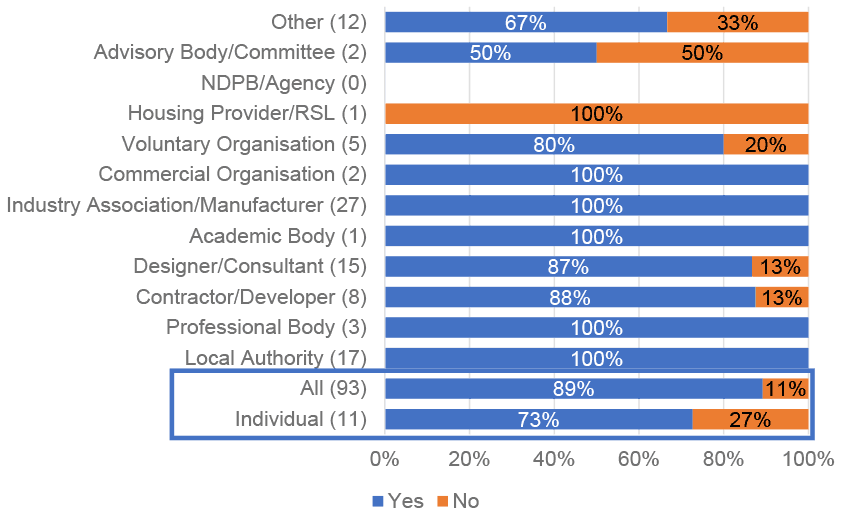
Base: 93 respondents (83 no response) NB Individual respondents are listed separately at the bottom for information – as they are included in organisation responses (per Section 2.3)
4.1.2 Analysis
There is support for the proposal with 89% of respondents in agreement and 11% rejecting the proposal (Figure 25).
4.1.3 Support for the proposal
The detailed comments vary, with many simply stating that renovation is a good time to consider energy performance improvements. Others state that the trigger point of 25% is both needed and appropriate.
Several respondents feel that that the proposal will support action on the provision of electric vehicle charging infrastructure or facilities, at least initially.
Several respondents focus on the breadth of application and would like to see this expanded. Respondents suggest that a major renovation should be a trigger to deliver energy performance improvements across ALL aspects and not just EVs.
A few respondents question why the definition only applies to the building surface with one suggesting that the installation of a heat pump, with new heat emitters, should be classed as a ‘major renovation’.
There is a call for regulations to be carefully drafted to avoid conflict with the PAS2035 whole house retrofit approach.
Several respondents draw attention to the fact that this proposal will bring Scotland into alignment with the rest of the UK.
Caution when drafting the proposals is advised by a few respondents who suggest that the regulations need to be drafted carefully to avoid conflict with the PAS2035 whole house retrofit approach.
4.1.4 Alternative metrics were proposed by a few respondents:
- Percentage of property value, especially in the domestic sector (10%).
- Where an element such as a roof is being upgraded, the upgrade must include improvements to the thermal performance, or else 25% of each individual element rather than the whole building envelope.
4.1.5 Not in support of the proposal
Of the 10 respondents who did not agree with the introduction of the term 'major renovation' as an additional means of identifying when aspects of building regulations shall be applied to an existing building, two made no further comment.
Several respondents raised concerns with the clarity of the term or alternative definitions. For example:
- Whether the replacement of 25% of the tiles on a roof would be classed as a major renovation.
- The definition should be based on the level of disruption for the occupants.
4.1.6 Non-responders
Six respondents who elected not to answer the multiple question offered a significant comment. Further discussion is sought in relation to small houses, e.g., will there be a minimum size of home to which the regulations will apply?
There is a call for clarity on what is meant by the ‘surface of the building envelope’.
One respondent drew attention to two scenarios which would not currently require a building warrant at present but may be classed as ‘major renovation’ moving forward - rendering a building and internal wall insulation
4.2 Revision of minimum performance for building fabric - Domestic
4.2.1 Quesiton 21
Do you support the proposed improvement in maximum U-values for elements of building fabric for domestic buildings?
There were 97 responses received in total to this question and 88 responses to the following open question where respondents were asked to provide more detail to support their answer. Ten respondents provided an open response but did not answer the multiple-choice question.
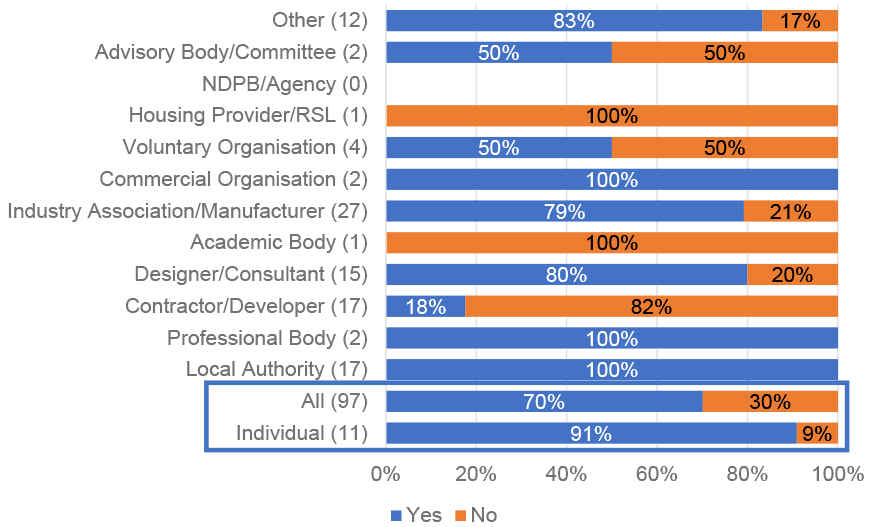
Base: 97 respondents (79 respondents) NB Individual respondents are listed separately at the bottom for information - as they are included in organisation responses (per Section 2.3)
4.2.2 Analysis
Seventy per cent of respondents support and 30% of respondents reject the proposed improvement in maximum U-values for elements of building fabric for domestic buildings (Figure 26).
4.2.3 Support for the proposal
The majority of respondents advocate a fabric first approach and expressed the view that this action is key to cutting greenhouse emissions.
A few respondents felt the maximum U-Values of building fabric of Domestic buildings could be improved upon, particularly for new build properties.
4.2.4 Not in support of the proposal
Those who stated they did not support the proposed improvement in maximum U-values for elements of building fabric for domestic buildings provided explanatory comments in the following areas:
- Several respondents stated that further changes to backstop U values could impact on design and construction methods.
- Risk of unintended consequences was raised by several respondents – such as increased costs for triple glazing to achieve the proposed U values, knock-on effects of heat recovery and vents or potential damage to building fabric.
- Viability of option 2 in relation to the U value of doors was raised by several respondents.
4.2.5 Non-responders
Of those who choose not to answer the multiple-choice question, ten provided comment. The main theme to those comments is agreement that improving the energy performance of ALL dwellings is essential to mitigate climate change, however, respondents stress that the requirements for retrofit of existing and traditional buildings must be proportionate and consider unintended consequences.
The need for the supply chain to be adequately prepared to deliver to these standards at the pace and scale required was also raised.
One technical response was received in relation to roofs and roof lights:
- U=0.11 for roofs means over 450 mm roof insulation; this might be technically problematic.
- For rooflights, U=1.9 and 1.7 are not realistic. U=2.2 (as adopted by DLUHC in England) may be the reasonable maximum.
4.2.6 We would also welcome your views on the proposed simplification (in Question 21) Achieved by the setting of a single set of values for all building work to new and existing domestic buildings
There were 61 responses received in total to this open question.
4.2.7 Analysis
Eleven respondents stated they had no comment, however, 21 respondents felt that the proposed simplification achieved by the setting of a single set of values for all building work to new and existing domestic buildings would avoid confusion, remove complexity, and provide benefits of consistency. It is felt to be beneficial for both designers and verifiers.
Many respondents raised concerns in relation to existing buildings. They highlighted that achieving the values is more challenging in the context of the existing buildings warn against a broad-brush approach. Flexibility in approach when dealing with buildings of traditional construction (e.g., stone, and slate properties; pre-1919; listed; within conservation area) is called for.
The omission of Window Energy Ratings as a compliance route is suggested to be an error by a few respondents.
4.3 Revision of minimum performance for building fabric – Non-domestic
4.3.1 Question 22 – Do you support the proposed improvement in maximum U-values for elements of building fabric for non-domestic buildings?
There were 76 responses received in total to this question and 68 responses to the following open question where respondents were asked to provide more detail to support their answer. Thirteen respondents provided an open response but did not answer the multiple-choice question.
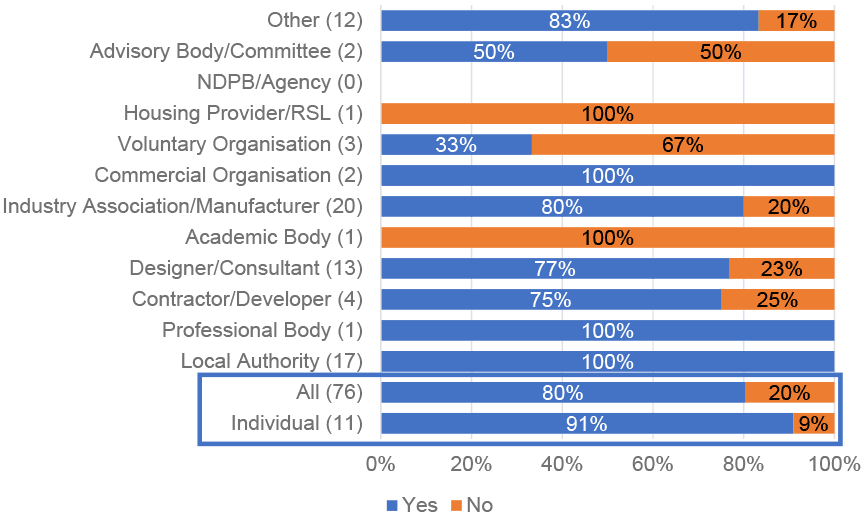
Base: 76 respondents (100 no response) NB Individual respondents are listed separately at the bottom for information – as they are included in organisation responses (per Section 2.3)
4.3.2 Analysis
There is significant support for the proposed improvement in maximum U-values for elements of building fabric for non-domestic buildings with 80% of respondents stating their support (Figure 27). The remaining 20% rejected the proposal.
4.3.3 Support for the proposal
A total of 41 comments were provided although seven simply stated they had no comment, or no view.
Substantive comments include:
- Non-domestic & domestic should be similar in standard.
- Advocate fabric first approach.
- Proposed u-values are ambitious but achievable with current technology and skills.
- Other aspects should be considered: thermal bridging, fenestration, air tightness, ventilation, air quality, heating systems & the use of heat recovery.
- Delivers improved consistency across the building stock, however, consideration is needed regarding the heterogeneous nature of building stocks.
- A whole building approach should be considered.
- Industrial developments can suffer from risk of overheating (where processes emit notable heat gains) – this should be considered.
- Window Energy Ratings (WER) and Door Set Energy Ratings (DSER) route to compliance should be retained in the regulations for non-domestic building that are domestic in nature.
4.3.4 Not in support of the proposal
Of the 15 who stated they do not support the proposal, several offered substantive comments:
- Two Industry Association/Manufacturer respondents raised concerns about achievement of u-values within the timescales specified and with specific reference to glass rooflights.
- Another Industry Association/Manufacturer respondent focused their comment on cavity widths, which they suggested should aim to not exceed 150 mm which equates to a U-value of 0.18.
- One Designer/Consultant respondent asked for clarity in relation to the target values for roof-lights which they believe have been relaxed from the current 2015 guidance.
4.3.5 Non-responders
Of those who provided a comment but did not answer the multiple-choice question, the majority stated that they have no comment or are not in a position to comment.
Four substantive comments were made each by one respondent:
- Supportive of a move to improve the fabric of the building although some concerns around the level at which this will be.
- Concern raised about possible unintended consequences as a result of the proposed standards.
- Requirements for retrofit of existing and traditional buildings must be included and must be proportionate.
- Suggest consideration should be given to the setting of a single set of values for ALL building work to new and existing buildings.
4.3.6 We would also welcome your views on the proposed simplification (in Question 22) achieved by setting a single set of values for all building work to new and existing non-domestic buildings.
There were 54 responses received in total to this open question.
4.3.7 Analysis
A substantial number of comments provide a limited response, offering either ‘no comment’ or simply confirming their support of the proposal.
Of the respondents who provided additional substantive commentary, three themes are apparent.
Several respondents cited the ease of understanding of the proposed simplification as a real benefit for the avoidance of confusion and one which will improve the efficiency of assessing the compliance of a proposal.
Several respondents noted that the proposed simplification will be more challenging in the context of some buildings for example, existing non-domestic and shell buildings.
The reinstatement of Window and Door Energy Ratings was cited by a few respondents, with two suggesting it should be retained for non-domestic buildings that are domestic in character, for example student accommodation
In addition to these themes a couple of other views were shared: one reiterating the benefits of standardisation across the UK. The other suggested that whilst a single set of U-Values would deliver improved productivity and economies of scale, the results for different dwelling typologies are likely to differ, resulting in variation of compliance levels.
4.4 Conversions, extensions, and shell buildings
4.4.1 Question 23
Do you support the proposed standardisation of values and approach for conversions, extensions, and shell buildings?
There were 74 responses received in total to this question and 63 responses to the following open question where respondents were asked to provide more detail to support their answer. Twelve respondents provided an open response but did not answer the multiple-choice question.
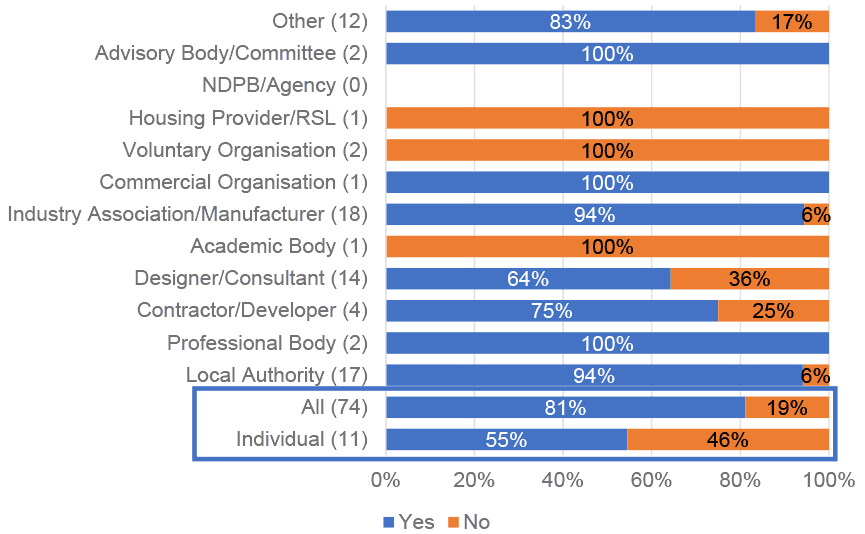
Base: 74 respondents (102 no response) NB Individual respondents are listed separately at the bottom for information – as they are included in organisation responses (per Section 2.3)
4.4.2 Analysis
Considerable support is apparent for the standardisation of values and approach for conversions, extensions, and shell buildings with 81% of respondents stating they support the proposal (Figure 28). Nineteen per cent of respondents reject the proposal.
4.4.3 Support for the proposal
Of the 60 respondents in support of the proposed standardisation of values and approach for conversions, extensions, and shell buildings, 40 provided comment. These comments offer general justification for their agreement stating it is sensible, provides clarity and, a better understanding of requirements. Several comments reinforce points made in relation to previous questions:
- Window and door energy ratings should be reinstated as a compliance route.
- The removal of the requirement to provide the more challenging fabric values in the shell, will lead to a reduction in the U values.
- Clarification needed as to what is ‘reasonably practicable’.
Of those who provide further comment but did not respond to the multiple-choice question, six offered substantive technical comment, largely in support of the proposed standardisation with some caveats:
Conversions
- Exemption process must be robustly defined, enforced, and monitored by BSD on an ongoing basis to reveal the extent to which this exemption is used.
- Not every conversion of an existing building is environmentally sustainable: where planning permission is required for a change of use, consent should be linked to the regulatory requirements.
- A compensatory approach must be retained for more difficult typologies (converted or upgraded historical buildings).
- For works to existing buildings additional regulatory requirements are recommended to support the demonstration of overall thermal compliance.
- Proper design detailing is of great importance when improving fabric efficiency to minimise the risk of unintended consequences.
- Area weighted values should follow those set out by the AECB retrofit standard and /or Passivhaus EnerPHit Standard.
Extensions
- An extension should be used as an additional trigger for ‘major renovation’.
- A step-by-step retrofit approach is beneficial, whereby the existing building is incrementally improved over time and once complete the extension typically contributes as a higher performing part of the overall building.
- Standards need to be as stringent as possible, whilst minimising the risk of unintended consequences.
- Area weighted values should follow those set out by the AECB retrofit standard and /or Passivhaus EnerPHit Standard.
Shell buildings
- The weakening of fabric efficiency standards relative to 2015 standards goes against the principle that a fabric first approach is the first energy efficiency measure.
4.4.4 Not in support of the proposal
Eleven comments were made by respondents who do not support the proposal, however, seven respondents provided details:
Conversions
- Such standardisation could discourage conversions.
- Not every conversion of an existing building is environmentally sustainable.
- A compensatory approach must be retained for more difficult typologies (converted or upgraded historical buildings).
- For works to existing buildings additional regulatory requirements are recommended to support the demonstration of overall thermal compliance.
Extensions
- An extension should be used as an additional trigger for ‘major renovation’.
- A step-by-step retrofit approach is beneficial, whereby the existing building is incrementally improved over time and once complete the extension typically contributes as a higher performing part of the overall building.
Shell Buildings
- Shell buildings should still comply with the regulations, to avoid cutting corners at the time at which the shell building is constructed.
4.5 Presentation of information on building services
4.5.1 Question 24
If you have a view on the preferred format for presentation of information on compliance of building services, what would be your preference?
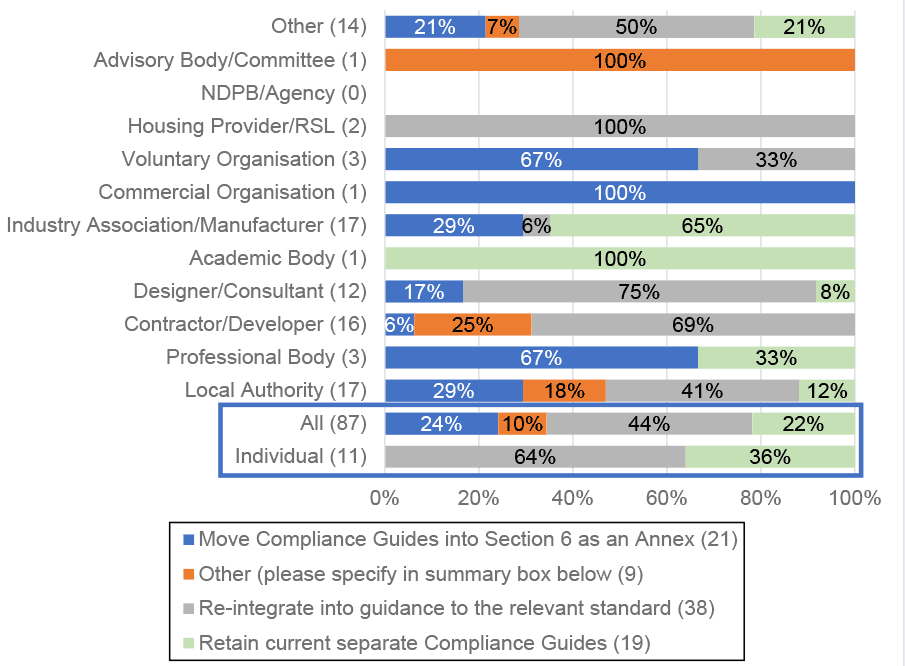
Base: 87 respondents (89 no response) NB Individual respondents are listed separately at the bottom for information - as they are included in organisation responses (per Section 2.3)
There were 87 responses received in total to this open question and 75 responses to the following open question where respondents were asked to provide more detail to support their answer. Eleven respondents provided an open response but did not answer the multiple-choice question.
4.5.2 Analysis
The majority of respondents (44%) favour the re-integration into guidance to the relevant standard. 24% opt for the movement of Compliance Guides into Section 6 as an Annex and 22% feel they should be retained as separate Compliance Guides. The minority (10%) responded to the question by stating ‘other’ (Figure 29).
4.5.3 Re-integrate into guidance to the relevant standard
Of the 38 respondents who were in favour of reintegrating into guidance to the relevant standard, 29 provided further comment. Several respondent comments – including a campaign response – reveal that it is seen as advantageous to have all the information in one place, making it easily accessible which avoids having to review separate documents simultaneously. It is suggested this will avoid or at least reduce the likelihood of a requirement being overlooked.
4.5.4 Move Compliance Guides into Section 6 as an Annex
Of the 21 respondents in favour of moving the Compliance Guides into Section 6 as an Annex, 16 provided further comment. Several noted the logic and ease of having all the information in one place and highlight that by locating the guides in an annex, separate annex the main text will not be ‘clogged up’ and the annex can be accessed easily as an when needed.
4.5.5 Retain current separate Compliance Guides
Of the 19 respondents who feel the format of the current separate compliance guides should be retained, 11 provided further comment. These respondents warned against change when change is not needed, particularly for the relatively short period of time (2022-24). They stated that re-integrating the information or adding as annexes would result in a large, difficult to navigate document.
4.5.6 Other
All nine of the respondents who selected ‘other’ in response to the question provided further comment. Four respondents stated they have no preference for the format. The only common theme to emerge is the importance of the information being in a fully searchable, electronic format.
4.5.7 Non-responders
Of the eleven respondents who chose not to answer the multiple-choice question but provide further comment, seven stated they had no comment or view, one stated they have no preference and another that Compliance Guides should be included in the Section 6 document.
4.6 Changes to minimum standards for building services - Domestic
4.6.1 Question 25
Do you support the continued alignment of minimum provisions for fixed building services at a UK level within the Domestic Building Services Compliance Guide?
There were 91 responses received in total to this question and 76 responses to the following open question where respondents were asked to provide more detail to support their answer. Thirteen respondents provided an open response but did not answer the multiple-choice question.
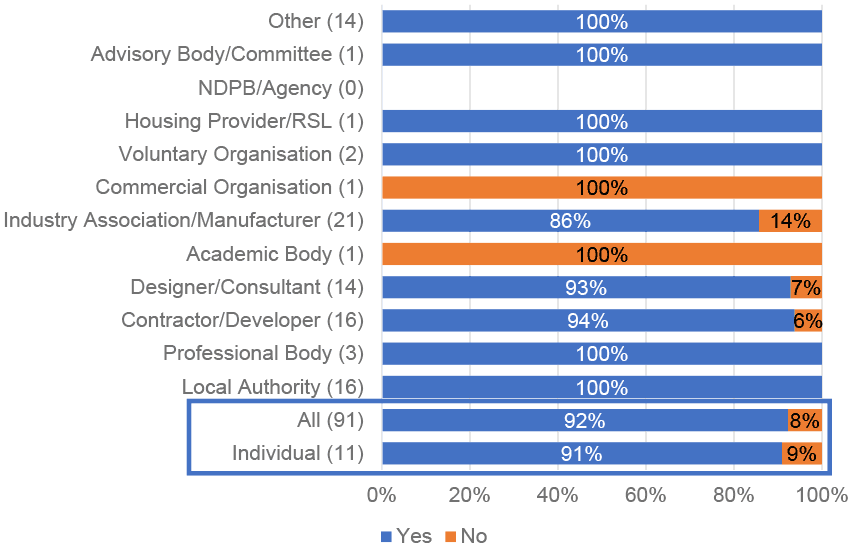
Base: 91 respondents (85 no response) NB Individual respondents are listed separately at the bottom for information - as they are included in organisation responses (per Section 2.3)
4.6.2 Analysis
Ninety-two per cent of respondents support the continued alignment of minimum provisions for fixed building services at a UK level within the Domestic Building Services Compliance Guide (Figure 30). Just 8% of respondents rejected the continued alignment of minimum provisions.
4.6.3 Support for the proposal
Fifty-seven of the respondents supportive of a UK wide approach offered a further comment to support their view, these followed a number of key themes:
- Promotes consistency and simplifies compliance.
- Beneficial for contractors who work across the UK.
- Provides a consistent Standard for the manufacture of components.
- Makes it easier to source equipment and fittings which meet standards if these are aligned nationally.
- Facilitates supply chain development.
4.6.4 Not in support of the proposal
Of the seven respondents who do not support the continued alignment of minimum provisions for fixed building services at a UK level within the Domestic Building Services Compliance Guide, four offered substantive further comment.
Three respondents (Commercial Organisation and two Industry Association/Manufacturers) submitting a campaign response noted that the use of compliance guides in England and Wales is no longer being supported and, only requirements are being retained within the approved documents. Furthermore, they state that the Compliance Guides provide essential information to developers and installers and are widely used by industry. As such, they suggested the Scottish Government should not adopt this approach.
4.6.5 Non-responders
Whilst 13 comments were made by those who did not answer the multiple-choice question, the majority of these respondents simply stated that they had no comment or no view. Five substantive comments were made, three referred to an opportunity for Scotland to raise the bar and to go beyond the standards being set elsewhere in the UK.
4.6.6 Are there any issues you wish to raise in relation to the amended specifications set out in the draft Guide?
There were 64 responses received in total to this question and 31 responses to the following open question where respondents were asked to provide more detail to support their answer. Twelve respondents provided an open response but did not answer the multiple-choice question.
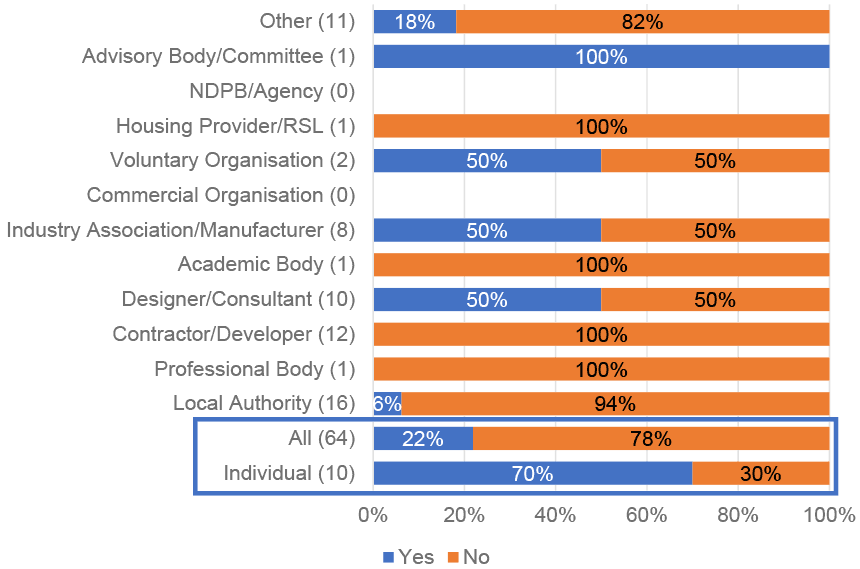
Base: 64 respondents (112 no response) NB Individual respondents are listed separately at the bottom for information - as they are included in organisation responses (per Section 2.3)
4.6.7 Analysis
Only 22% of respondents stated that they wished to raise any issues in relation to the amended specifications set out in the draft Guide (Figure 31).
Of the 14 respondents who stated they wished to raise an issue in relation to the amended specifications set out in the draft Guide, all provided further comment with varying levels of detail and technicality.
A few respondents stated that all clarifications and additional details are welcome in terms of increasing compliance.
Other responses include (provided by separate respondents):
- In all situations there should be a focus on a ‘fabric first’ approach: we should disincentivise the addition of on-site micro-generation equipment until the building fabric has been sufficiently improved to reduce the overall energy demand and performance of the whole building.
- Insisting on ‘zero energy’ buildings could encourage lower density construction which has other negative impacts on the environment in relation to land and resource efficiency. Instead, a holistic approach should be adopted.
- Legislation should be developed and introduced to adequately address the extensive levels of retrofit necessary to combat carbon emissions relating to all aspects of construction, in conjunction with adequate training and financial support.
- Regulations should introduce metrics that are absolute rather than relative to notional targets.
- Regulation should incentivise a longer lifespan approach.
- Compliance methodologies should be improved to reduce the difference between predicted energy use and actual.
- The PHPP (Passivhaus Planning Package) software is a proven whole building energy efficiency calculation tool – this could be introduced as an alternative to the SAP methodology. This could be regulated through the existing Section 6 Certifiers scheme.
- PAS 2035 could be utilised as a management framework system to implement these ideas, however due consideration must be given in the first instance to the design and detailing of all works to buildings to ensure the predicted performance benchmarks match those delivered in reality.
The content of the remaining responses was of a highly technical nature.
4.6.8 Non-responders
Of the twelve who did not answer the multiple-choice question but provided a comment, two of these were substantive and technical in nature.
4.7 Changes to minimum standards for building services – Non-domestic
4.7.1 Question 26
Do you support the continued alignment of minimum provisions for fixed building services at a UK level within the Non-domestic Building Services Compliance Guide?
There were 69 responses received in total to this question and 55 responses to the following open question where respondents were asked to provide more detail to support their answer. Thirteen respondents provided an open response but did not answer the multiple-choice question.
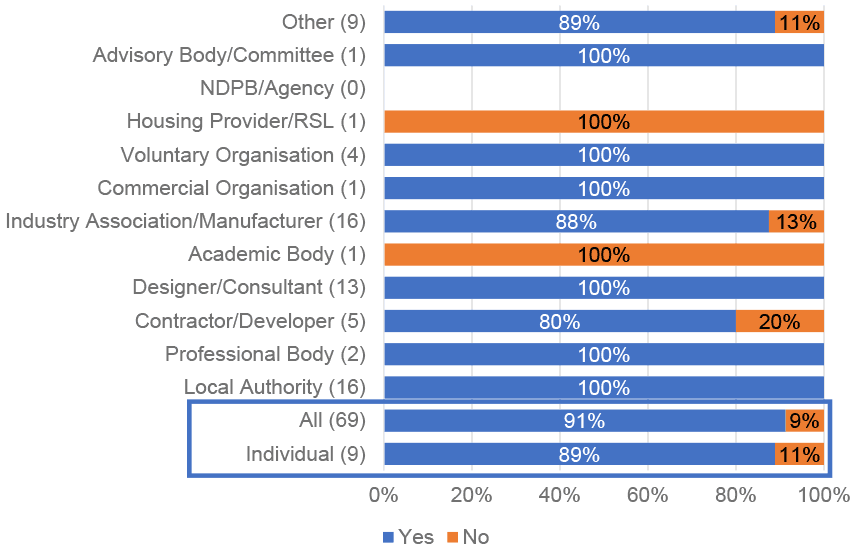
Base: 69 respondents (107 no response) NB Individual respondents are listed separately at the bottom for information - as they are included in organisation responses (per Section 2.3)
4.7.2 Analysis
There is considerable support for the continued alignment of minimum provisions for fixed buiding services at a UK level within the Non-domestic Building Services Compliance Guide – 91% of respondents support the proposal and just 9% reject it (Figure 32).
4.7.3 Support for the proposal
Those 63 respondents in favour of the proposal primarily drew attention to the ease of implementation, clarity, and consistency the continued alignment will bring. Respondents felt it would be simpler for building services designers and contractors, working across the UK. In addition, respondents noted the benefits to manufacturers who can apply the same strategy across a range of products, leading to greater efficiency, cost savings and consistency with spare parts.
4.7.4 Not in support of the proposal
Only two substantive comments were received from the six respondents who stated they do not support the continued alignment of minimum provisions for fixed building services at a UK level within the Non-domestic Building Services Compliance Guide. One suggested the Scottish Government should not remove information guidance and good practice recommendations; the other pointed to a need to prepare for the transition in relation to water heating systems.
4.7.5 Non-responders
Only four of the thirteen comments made by those who did not respond to the multiple-choice question offered substantive comment, predominantly in support of the proposal deemed to ‘encourage consistency’ and ‘reduce confusion’.
4.7.6 Are there any issues you wish to raise in relation to the amended specifications set out within the draft Guide?
There were 50 responses received in total to this question and 26 responses to the following open question where respondents were asked to provide more detail to support their answer. Fourteen respondents provided an open response but did not answer the multiple-choice question.
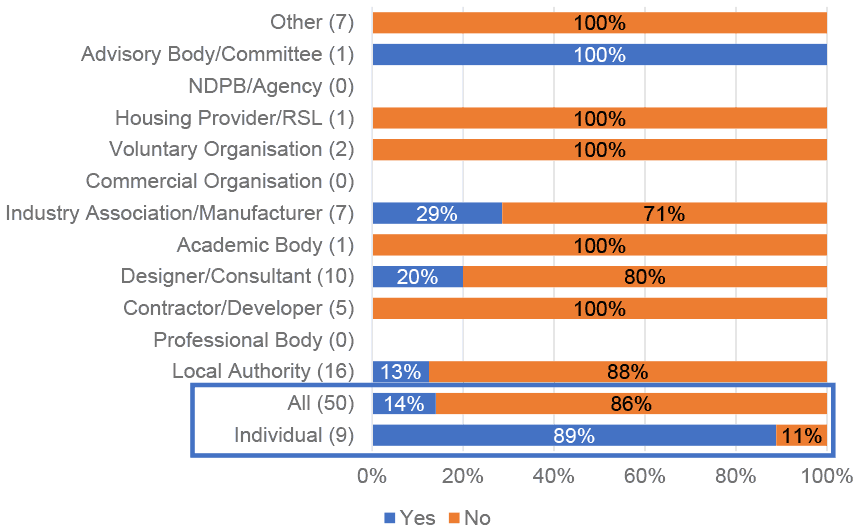
Base: 50 respondents (126 no response) NB Individual respondents are listed separately at the bottom for information - as they are included in organisation responses (per Section 2.3)
4.7.7 Analysis
The majority of respondents (86%) stated that they did not wish to raise any issues in relation to the amended specifications set out within the draft Guide (Figure 33). Whilst 14% of respondents (7) stated they wished to raise an issue, the majority of these referred to issues already raised in relation to previous questions.
Of the 26 open responses, the majority stated they have no further comment or issues to raise. The four substantive comments received have no commonality in their content.
4.8 Removal of heating efficiency credits – Non-domestic
4.8.1 Question 27
Do you agree with the proposal that the option of installing a less efficient heat generator and compensating for this using heating efficiency credits in existing buildings should be withdrawn from the Non-domestic Buildings Services Compliance Guidance?
There were 64 responses received in total to this question and 55 responses to the following open question where respondents were asked to provide more detail to support their answer. Ten respondents provided an open response but did not answer the multiple-choice question.
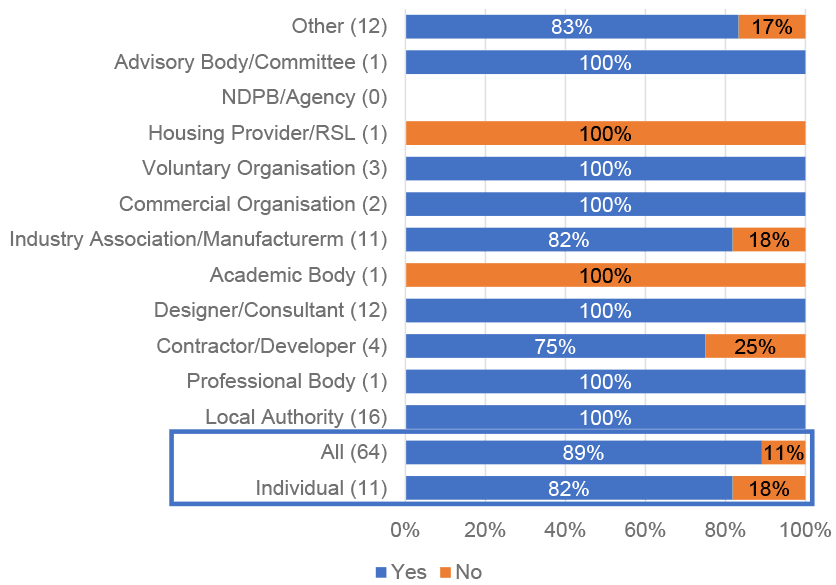
Base: 64 respondents (112 no response) NB Individual respondents are listed separately at the bottom for information - as they are included in organisation responses (per Section 2.3)
4.8.2 Analysis
The proposal gained significant support - 89% (57) of respondents stated they agree that the option of installing a less efficient heat generator and compensating for this using heating efficiency credits in existing buildings should be withdrawn from the Non-domestic Buildings Services Compliance Guidance (Figure 34).
4.8.3 Support for the proposal
There are two common themes in the responses:
- This ‘trade off’ is no longer justified or necessary due to significant improvements in the energy efficiency of appliances.
- Compensation should be avoided (allowing it to remain risks allowing inefficient heat generators to be deliberately installed).
In general, those in support highlight that the current guidance was complicated for the occasional user of the guide and that the change will encourage system upgrading and innovation.
4.8.4 Not in support of the proposal
Only 11% (7) of respondents to this question stated they don’t agree that the option of installing a less efficient heat generator and compensating for this using heating efficiency credits in existing buildings should be withdrawn from the Non-domestic Buildings Services Compliance Guidance. Only two of these respondents offered substantive comments in support of their view, pointing to:
- Technological and economic considerations from a consumer perspective that need to be addressed, and;
- The potential to encourage the potential deployment of higher carbon and not fit-for-purpose technology, rather than low carbon solutions.
4.8.5 Non-responders
Of the 10 comments received from respondents who did not respond to the multiple-choice question, the majority (eight) stated they have no view or no comment. One respondent felt that there is no longer a need for this measure due to the improvement in energy efficiency of appliances over recent years. The other respondent stated that it is now easier to install efficient heat generators due to improvements in heat generator efficiency.
4.9 Limiting distribution temperature for wet heating systems
4.9.1 Question 28
Do you agree with the proposal to limit distribution temperatures in wet central heating systems to support effective implementation of low and zero carbon heat solutions and optimise the efficiency of heat generation and use?
In total, 105 responses were received to this question. Ninety-five gave answers to the multiple choice yes/no question and 67 responses were provided to the accompanying open question, where respondents were asked to provide more detail to support their answer. An additional ten open responses were given without the respondent answering the multiple-choice question.
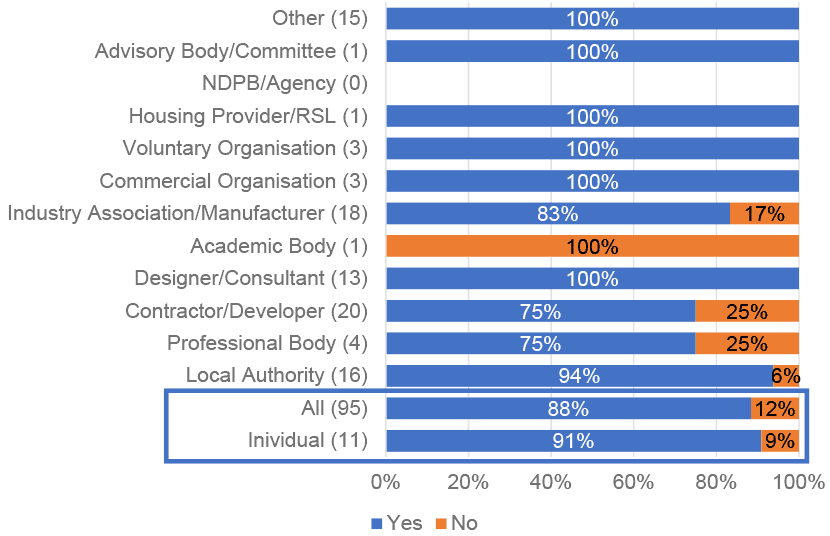
Base: 95 respondents (81 no response) NB Individual respondents are listed separately at the bottom for information - as they are included in organisation responses (per Section 2.3)
4.9.2 Analysis
Eighty-eight per cent of respondents answered ‘yes’ to the question posed, while 12% answered ‘no’ (Figure 35). Of the 84 respondents who answered ‘yes’, 57 provided extra comment in the open question. Of the 11 who disagreed with the proposal, nine provided additional comment.
The majority of respondents showed support for the proposal to limit distribution temperature in wet central heating systems (to support effective implementation of low and zero carbon heat solutions and optimise the efficiency of heat generation and use).
Of the overall 84 positive responses to the proposal, 79% broadly agreed, with either minimal or no additional comment offered. Twenty-one per cent agreed with the proposal and provided additional insight and opinions. Nine (of 11) respondents who did not support the proposal also provided additional information.
4.9.3 Support for the proposal
Overall, respondents agreed that limiting distribution temperatures in wet central heating systems would be reasonable to optimise energy efficiency and help meet targets. It was felt that this seemed a “sensible approach”, which would provide both energy and costs savings, future-proofing building and reducing the need to retrofit decarbonised heat sources in coming years.
Recurrent themes presented by those in favour of the proposal to limit distribution temperatures in wet central systems:
- Several respondents called for additional guides and explanation, including tightening of wording to avoid any ambiguity. A part of this a few respondents suggested that the implications of moving from other methods of heating to a low carbon heating method should be explained to the end-user upon completion of the installation.
- Several respondents pointed to challenges with the uptake of the proposal for older or traditional buildings.
- A few respondents were of the opinion that the standard be set lower than 55 degrees.
Additionally, a few respondents who did not answer the multiple-choice question provided additional information. While they agreed with the proposal, they raised concerns with retrofitting existing buildings; if existing homes needed radiators to be replaced, consideration should be given to the embodied carbon of current radiators in good condition within buildings, compared with the carbon saving by replacing them.
4.9.4 Not in support of the proposal
Those who answered that they did not support the proposal to limit distribution temperatures, did so for largely the same reasons that are already discussed above.
Additional information provided centred mainly on the fitness of this proposal for pre-existing buildings. As already noted, there was concern that while this proposal may be viable in new and modern buildings, it could be problematic in older buildings. One respondent noted that this is because of the way older building have been designed and constructed, which may make the cost benefit ratio unattractive.
4.10 Self-regulating devices
4.10.1 Question 29
Do you agree with the proposed extension to the provision of self-regulating devices to include when replacing a heat generator?
In total, 95 responses were received for this question. Eighty-three responses were received to the yes/no portion of this question, of which 10 were from individuals and 73 from organisations. Forty-seven responses were provided to the accompanying open question where respondents were asked to provide a summary of the reason for their view. Only three of the open-text responses were from individuals. Twelve respondents did not answer the yes/no section but did provide additional comment in the open question.
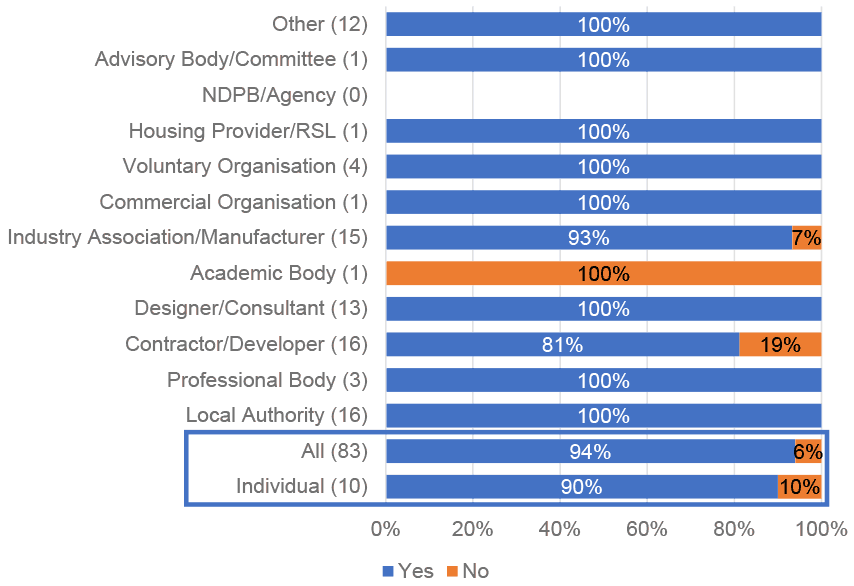
Base: 83 respondents (93 no response) NB Individual respondents are listed separately at the bottom for information - as they are included in organisation responses (per Section 2.3)
4.10.2 Analysis
Overall, most respondents supported extending the provision of self-regulating devices to include installation (where absent) at the point a heat generator is replaced, with 94% of respondents being in favour (Figure 36).
Twenty-nine per cent of respondents agreed with the proposal and provided additional insight and opinions. Two (of five) respondents who did not support the proposal also provided supporting reasons.
4.10.3 Support for the proposal
Of the 78 respondents (94%) who agreed with the extension of the provision, 34 (41%) provided no further responses and 20 (24%) provided limited responses confirming their support of the proposal. Twenty-four respondents (29%) agreed and provided additional commentary.
Among these 20 respondents who gave limited answers to this question, it was generally felt that the measures were reasonable and proportionate, with the heat generator being an appropriate intervention point. One contractor/developer noted “this is sensible and is already an industry standard”.
Of the 24 respondents (29%) who agreed and provided additional commentary, two main themes appeared:
- Many respondents felt that the proposal will provide building occupants with increased energy efficiency and control over energy bills.
- Several respondents also noted that the proposal has the potential to increase occupant comfort by providing control and flexibility to adjust the temperature in different heating zones or rooms. A few respondents stated how further technological advances in smart thermostat controls should help occupants realise this benefit, in addition to mitigating instances of overheating.
In addition to these two main themes, a few respondents reiterated the importance of understanding challenges pertaining to older and traditional buildings in the consultation process. There was consensus that older heating systems may provide technical challenges in the installation of self-regulation devices. There was also an appreciation of how the layout and design of older and traditional buildings may cause specific challenges, in addition to unique energy saving opportunities.
4.10.4 Not in support of the proposal
Five respondents did not agree with extending the provision. One contractor/developer respondent suggested the proposal should be investigated further with heat pump engineers, believing that “flow should not be restricted and that heat pumps work best with a large volume continuous low temperature flow throughout the home.” Similarly, an industry association/manufacturer respondent held the view that extending the provision should be an engineering design decision, rather than a regulatory requirement.
4.11 Issues on technical feasibility of self-regulating devices
4.11.1 Do you have any comment on issues of technical feasibility or determining when installation (per Question 29) should be at a room/zone level?
Sixty responses to this question were received (Figure 37) and thirty-seven to the open question which asked for comments on issues of technical feasibility or determining when installation should be at a room/zone level. Seventeen respondents provided an open response but did not answer the preceding closed ‘yes/no’ question. Most of these respondents stated ‘no comment’.
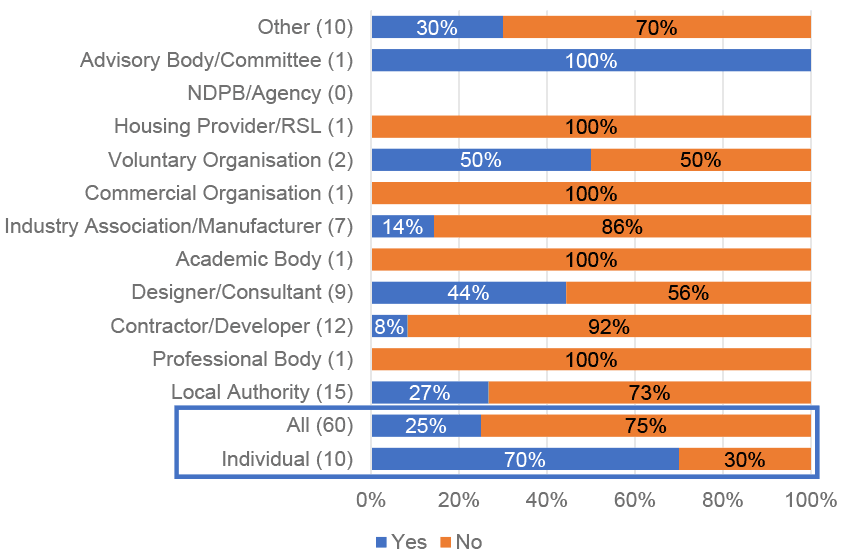
Base: 60 respondents (116 no response) NB Individual respondents are listed separately at the bottom for information - as they are included in organisation responses (per Section 2.3)
4.11.2 Analysis
Out of the 15 ‘yes’ responses, 14 respondents supported their answer by providing commentary on issues of the feasibility and installation of self-regulating devices at a room/zone level. Of these 14 responses, two were from individuals and 12 were from organisations.
The general sentiment among the respondents was that technical feasibility should be considered on a case-by-case basis, dependant on the building and the expertise of the installer / engineer.
Several respondents did not answer the yes/no question but provided substantial open-text responses in favour of the proposal:
- Training requirements need to be addressed as part of implementing the proposal.
- More information is needed, for example, how the system could be incorporated within a plot.
- A study on the number of occupants in the various rooms and the hourly and daily usage of the spaces.
- The provision should mirror the current installation and the practicality of adding self-regulating devices.
A few respondents noted the considerable cost and time impact for existing building alongside the dependency on existing infrastructure.
A few other respondents supported this point, confirming that the answer could depend on the way the buildings heating system had been piped-up.
A few respondents cautioned the challenging nature of retrofitting existing buildings.
4.12 Building Automation and Control Systems – Non-domestic
4.12.1 Question 30
Do you agree with the proposed introduction of a requirement for building automation control systems, of the type specified, in larger non-domestic buildings with systems with an effective rated output over 290 kW?
Sixty respondents answered this question and 53 responses to the accompanying open question. Sixteen respondents answered the open question but did not respond to the preceding closed ‘yes/no’ question.
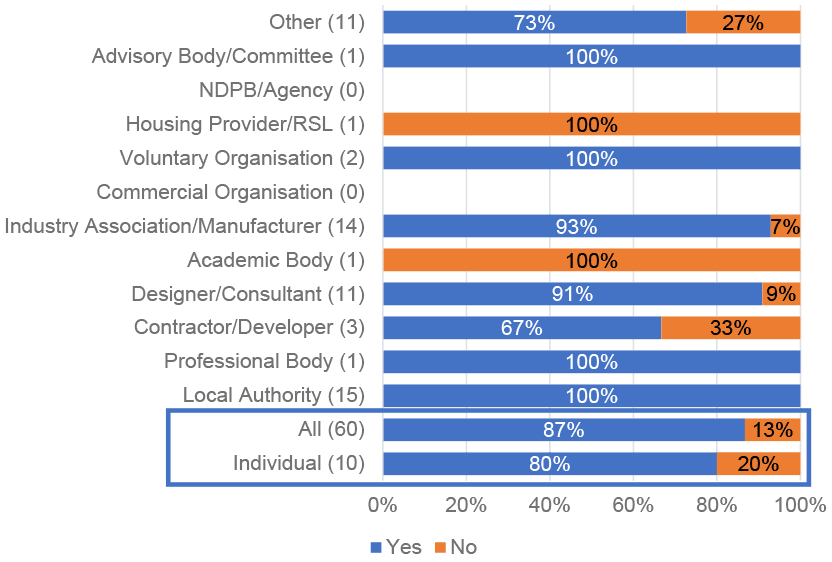
Base: 60 respondents (116 no response) NB Individual respondents are listed separately at the bottom for information - as they are included in organisation responses (per Section 2.3)
4.12.2 Analysis
Overall, 87% agree with the proposal and 13% disagree (Figure 38). Eight ‘no’ responses were received to this question, three of which contained substantial text.
Out of the 52 ‘yes’ responses, 28 were very short statements confirming support with language such as “reasonable”, “sensible” and “necessary” in reference to the proposal.
4.12.3 Support for the proposal
The general sentiment of responses was positive, with a consensus among respondents that correctly configuring and utilising building automation control systems leads to greater energy efficiency, user benefits and cost savings.
There was notable divergence on the 290 kW threshold, as summarised below with a few respondents were curious over how the threshold had been derived, with two questioning why it was so high.
A few respondents commented on the importance of the way in which the system is controlled.
A few other respondents highlighted the cost of installing building automation control systems.
Additionally, two respondents did not answer the yes/no question but provided substantial open-text responses in favour of the proposal.
4.12.4 Not in support of the proposal
Three of the eight ‘no’ responses to this question, contained text with opinions and insights:
- The proposal should be optional due to the associated costs of building automation and control systems.
- The 290 kW threshold level was felt to be too high or, should rather be set proportionally with the building floor size.
- Non-residential buildings of over 400 m2 to be equipped with automatic lighting control systems, where technically and economically feasible.
4.13 Further comments on setting minimum standards for all buildings
4.13.1 Question 31
We welcome any other comments you may wish to make on these topics and broader changes to the setting of minimum standards for all buildings.
4.13.2 Analysis
While a total of 61 responses were received to this open question, only 28 gave substantive additional information, with 33 responses reading as variations of “no further comment”. A number of clear themes are discernible from this open response question.
The main theme highlights the need for a fabric first approach. Many respondents put forward this idea that a whole-building fabric first approach should be the considered in the very beginning of any plans to reduce carbon emissions. An additional three respondents noted that the performance gap must be addressed where it related to both services as well as building fabric.
A few respondents stated a desire for more information, notably guidance in the Technical Handbooks and supplementary guidance with examples to aid verifiers and designers. Specifically, this should cover efficiency of services and installation.
The role of certifiers and verifiers was mentioned by a few respondents: considering the impact on their time and a concern that exempt work under Regulation 5 could be unchecked.
A few respondents highlighted retrofitting, ensuring this is not discouraged if regulations become too onerous, and can be achieved in a sustainable way.
A few respondents raised concerns about older buildings vs new builds, notably that balance needs to be achieved between improving energy performance and efficiency and avoiding damage to both the significance of the building and its fabric.
4.13.3 Other considerations
Six other points were raised:
- Embodied carbon and operational energy performance should be considered.
- The difference between domestic and non-domestic builds should be made clear, as not all non-domestic buildings are suited towards low-carbon heating and hot water (especially low-temperature heating systems).
- Existing housing stock is likely to be largely inefficient. For this reason, grants should be provided to help improvements, on the provision that work is approved by verifiers.
- Three responses discussed the use of hydrogen as a source of future clean energy. They noted that a huge investment infrastructure is needed for the building industry to make the shift to completely green hydrogen.
- Further guidance and support should be directed toward on-site green storage.
Contact
Email: buildingstandards@gov.scot
There is a problem
Thanks for your feedback